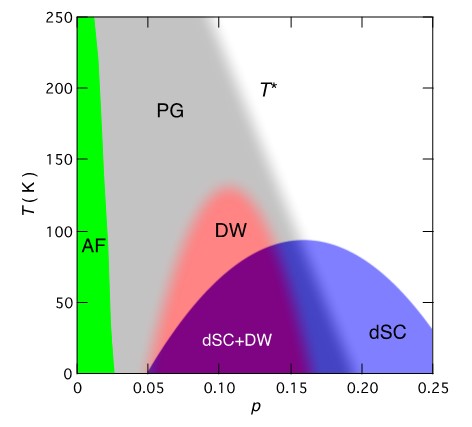Andrey Chubukov
(University of Minnesota, USA)
Bernhard Keimer
(Max Planck Institute for Solid State Research, Germany)
Mohit Randeria
(Ohio State University, USA)
Suchitra Sebastian
(University of Cambridge, UK)

High temperature superconductivity has proved both a source of great excitement and deep mystery since the first discovery of the copper oxide superconductors in the 1980s and the recent discovery of the iron pnictide superconductors. The wast majority of researchers agree that, to understand superconductivity, one needs to understand first the normal state of these materials. The latter, is, however, highly non-trivial and contains, e.g., the pseudogap phase in the cuprates and the nematic phase in iron pnictides and chalcogenides. Arriving at a theoretical understanding of the normal state in both these materials is particularly challenging given the likely involvement of multiple of these contributing factors. Within the last few years, however, an infusion of new experimental results has finally made a resolution of normal state physics in the family of high temperature superconductors a tangible possibility. The workshop will focus on in-depth discussion of the origin of the pseudogap in the cuprates (e,g, whether it is a precursor to some other state or a state with broken symmetry) and of unconventional normal state properties of Fe pnictides and chalcogenides. Similarities and differences between these two classes of high-temperature superconductors will be discussed.
• James Analytis (University of California, Berkeley, USA)
• Neven Barišić (Technische Universität Wien, Austria)
• Elena Bascones (ICMM-CSIC, Madrid, Spain)
• Sergey Borisenko (IFW Dresden, Germany)
• Bernd Büchner (IFW Dresden, Germany)
• Amalia Coldea (University of Oxford, UK)
• Luca de' Medici (ESPCI, Paris, France)
• Rafael Fernandes (The University of Minnesota, Minneapolis, USA)
• Yann Gallais (Université Paris Diderot, France)
• Neil Harrison (Los Alamos National Laboratory, USA)
• N.E. Hussey (Radboud University Nijmegen, The Netherlands)
• Marc-Henri Julien (LNCMI CNRS, Grenoble, France)
• Aharon Kapitulnik (Stanford University, USA)
• Hiroshi Kontani (Nagoya University, Japan)
• Alessandra Lanzara (University of California, Berkeley, USA)
• Dung-Hai Lee (University of California, Berkeley, USA)
• Mathieu Le Tacon (MPI for Solid State Research, Stuttgart, Germany)
• Andrew Mackenzie (MPI for Chemical Physics of Solids, Dresden, Germany)
• Yuji Matsuda (Kyoto University, Japan)
• Walter Metzner (MPI for Solid State Research, Stuttgart, Germany)
• Andrew Millis (Columbia University, New York, USA)
• Catherine Pépin (CEA Saclay, Gif-sur-Yvette, France)
• Srinivas Raghu (Stanford University, USA)
• T. Maurice Rice (ETH Zürich, Switzerland)
• Subir Sachdev (Harvard University, Cambridge, USA)
• Jörg Schmalian (Karlsruher Institut für Technologie, Germany)
• Louis Taillefer (Université de Sherbrooke, Canada)
• Oskar Vafek (Florida State University, Tallahassee, USA)
• Chandra Varma (University of California, Riverside, USA)
• Matthias Vojta (Technische Universität Dresden, Germany)

courtesy of K. Fujita